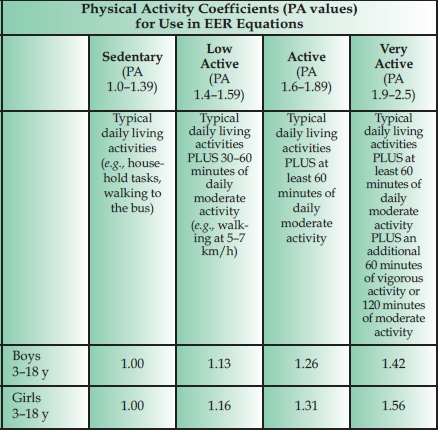Q. What are the recommended macronutrient needs of school-age and preadolescent children? And why are certain healthy fats important in children’s nutrition?
A: Children need a variety of foods that are moderately balanced for optimal energy, growth and development. The recommended Dietary Reference Intakes (DRIs) for macronutrients (e.g., carbohydrates, protein and fat) and micronutrients (e.g., vitamins and minerals) have been established for children. As of 2002, the appropriate amount of calories for children is based on the Estimated Energy Requirements (EER), which has been defined as the total energy expenditure plus kilocalories for energy disposition. For boys and girls, the mathematical calculations are as follows:
Boys 3 to 18: EER = 88.5 - (61.9 x age [y]) + PA (physical activity) x {(26.7 x weight [kg]) + (903 x height [m])} + 20
Girls 3 to 18: EER = 135.3 - (30.8 x age [y]) + PA (physical activity) x {(10.0 x weight [kg]) + (934 x height [m])} + 20

The caloric needs for kids will decrease per kilogram of body weight over time as a reflection of the slowing growth rate. Below is a table that lists the differences in macronutrient requirements between children and adults represented as a percentage of total calories consumed in a day:

Although bad fats from processed/fast foods should be avoided, certain healthy fats play a critical role in a person’s overall intelligence that is largely built during the childhood years starting from conception. In particular, the omega-3 fatty acid called docosahexaenoic acid (DHA) plays a critical role in children’s brain and eye health. It’s surmised that the ratio intake of omega 6 to omega 3 is 20:1 and really should be 4:1 or 2:1 for good health. That is why the nutritional scientists at Bluebonnet formulated Super Earth® Rainforest Animalz® DHA Fish-Shaped Softchews to supply 100 mg of DHA from tuna fish oil that is not only gluten-free, but also is sweetened with xylitol. Aside from being an effective sweetening agent, xylitol has also been found to be beneficial in reducing the chance for dental caries.
Q. What are some of the most common nutrient deficiencies in children and their potential consequences?
A. According to the World Health Organization, malnutrition is responsible for more than 5.2 million child deaths annually and is also a source of disease and disability in those who survive. In developing countries, children’s micronutrient deficiencies typically include vitamin A, iodine and iron. Malnutrition actually takes on a different form in the United States and other First World countries. It typically occurs not because of the lack of food since more than a third of American kids are overweight, but because of the lack of the right types and balance of foods and the high consumption of processed/fast foods. Currently, school-aged children are over-consuming saturated and trans-fatty acids and are not meeting the daily recommendations of fruits and dark leafy greens. Therefore, the most common nutrient deficiencies seen today are calcium, fiber, folate, iron, magnesium, potassium and vitamins D and E, and their potential health consequences range if depletion is ongoing.
 Q. Other than to prevent nutrient deficiencies, why would a child require dietary supplementation?
Q. Other than to prevent nutrient deficiencies, why would a child require dietary supplementation?
A. Many children are picky eaters and avoid many of the whole foods that provide the greatest nutritional benefit. Taking a whole food based children’s multinutrient formula serves as a nutritional insurance policy guaranteeing that children get all the essential vitamins and minerals they require on a daily basis by sneaking in all the healthy fruits and vegetables kids love to hate. No matter what a child’s activity level, dietary habits, gender or health status, augmenting his or her diet with a line of whole food based supplements that supply crucial vitamins, minerals and nutrients through super foods can be the perfect antidote for optimal energy, growth and development. Each formula in the Bluebonnet’s Super Earth® Rainforest Animalz® line includes a whole food component, such as super fruits, vegetables, whole grains, fiber and/or essential omega fats.
Q. Why is whole food based nutrition important for children?
A. It is no secret that most diets, particularly those of children, are typically comprised of sweets and junk/processed foods. These Western diets often lacking in fruits, vegetables and whole grains have been linked to many of the health issues Americans face today. Even prestigious research institutions, including the National Cancer Institute, are urging Americans to eat more varied, well-balanced diets that are rich in dark, leafy greens. This is due to the multitude of active components (phytonutrients) provided by green foods, fruits and whole grains grown locally, which have been shown in research to play an important role in the healthy maintenance of the human body. However, in today’s fast-paced world, adults and children alike are on the go and rely on processed/fast foods and not on a well-balanced, nutritious diet. Most children do not get the daily recommended allowance of vitamins, minerals and other nutrients that are required for optimal health and wellness. Both vitamins and minerals are fundamental to children’s energy, growth and development. Whole food based supplements for children, like Bluebonnet’s Super Earth Rainforest Animalz line, which include super fruits, help to bridge the nutrient gaps in the daily diets.
References
Alaimo K, Olson CM, and Frongillo EA. "Food Insufficiency and American School-Aged Children's Cognitive, Academic and Psychosocial Developments." Pediatrics 108.1 (2001): 44-53.
Cavadini C, Siega-Riz AM, Popkin BM. U.S. adolescent food intake trends from 1965 to 1996. Archives of Disease in Childhood 2000;83(1):18-24.
Lin BH, Guthrie J, Frazao E. American children’s diets not making the grade. Food Review 2001;24(2):8-17.
U.S. Department of Health and Human Services and U.S. Department of Agriculture. Dietary Guidelines for Americans, 6 Edition, 2005. Washington, DC, U.S. Government Printing Office of Science
 Trisha Sugarek holds a Master’s of Science in Nutrition from Texas Woman’s University and also a Bachelor’s of Science degree in Nutrition and Food Sciences from Texas State University. Ms. Sugarek is currently the National Educator at Bluebonnet Nutrition as well as a Research & Development Specialist where she investigates new ingredients, assists in the launch of new products, and provides industry training on numerous subjects as it relates to the connection between nutrition and health. She is a frequent editorial contributor and lecturer on the benefits surrounding the responsible use of supplements.
Trisha Sugarek holds a Master’s of Science in Nutrition from Texas Woman’s University and also a Bachelor’s of Science degree in Nutrition and Food Sciences from Texas State University. Ms. Sugarek is currently the National Educator at Bluebonnet Nutrition as well as a Research & Development Specialist where she investigates new ingredients, assists in the launch of new products, and provides industry training on numerous subjects as it relates to the connection between nutrition and health. She is a frequent editorial contributor and lecturer on the benefits surrounding the responsible use of supplements.
Published in WholeFoods Magazine, August 2011










